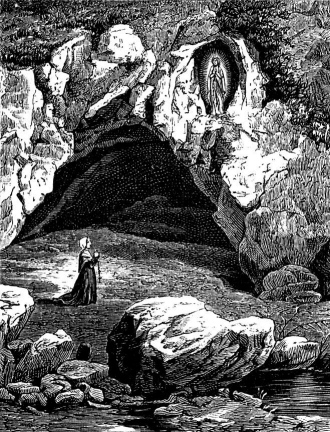
Lourdes, 26 June 2006 — People pack a cavernous underground church in this vast Roman Catholic sanctuary at a recent afternoon mass – one of several taking place daily at Lourdes. On this recent weekend, thousands of pilgrims have come here to find spiritual solace – or perhaps, a miraculous cure.
Among the sick is Jim Quinn, an English man in his 50’s. Quinn is nearly paralyzed from Parkinsons disease. As he is pushed to dinner in a wheelchair, he talks to a reporter about what draws him to Lourdes. It’s hard for him to speak above a whisper.
“It’s all about other people,” he says. “You don’t think about yourself. It’s who you meet on the street or in church, or in the crowd that needs help. It’s nothing about personal cures – although I’m sure there have been some.”
Lourdes is perhaps Europe’s most popular pilgrimage site. Not only because a local girl is said to have had apparitions of the Virgin Mary in 1858, but also because of miraculous healings that are said to be linked to this mountain town. There have been about 7,000 claims of miracle healings, to date. However, the Catholic church has only recognizes 67.
Under Vatican rules drafted nearly 200 years ago, miraculous healings must take place almost instantly – and people must be permanently cured. Those cured also cannot benefit from previous medical treatment. But these days most people go to doctors for treatment when they fall ill.
So in March, the regional diocese issued new rules – relaxing guidelines not for miracles, but for other, unexplained healings. The church now recognizes three types of surprising healings: Unexpected, confirmed and exceptional.
Skeptics suggest the new directives are aimed to counter the growth of rival evangelical churches and pilgrimage sites elsewhere. But Monseigneur Jacques Perrier, bishop of Lourdes and Tarbes, dismisses such criticism.
Monseigneur Perrier says the church and Lourdes special medical committee have been discussing these changes for years. He says, what has evolved with the times is not faith, but medical science.
The Lourdes medical committee meets yearly to decide whether several dozen claims of miracles can be explained scientifically. If not, the committee recommends the claims to Perrier – who makes the final ruling over whether the claims meet religious criteria for miracles. Dr. Francois Bernard Michel is head of the medical committee.
Bernard Michel says people think nothing extraordinary is happening at Lourdes, any more. However, he says things are happening and they the sanctuary cannot reject declarations of cures made by people in good faith.
Church attendance may be plummetting in Europe, but Lourdes reputation for healing and meditation draws about six million pilgrims to the town, each year. And, the numbers are growing. Today, Lourdes is awash with hotels that offer services for the sick and tour shops selling religious memorabilia.
Along with tourists, the town has drawn new residents like 62-year-old Jean Marmon. A former butcher, Marmon moved to Lourdes six years ago. Today, he has a shop selling cured ham and sausages and a sharp-tasting local cheese called Tomme des Pyrenees.
Marmon says his clientele comes from many different cultures. People tell him about miraculous cures they have witnessed or heard about. Marmon believes they are sincere, but he is not sure he believes their stories are true.
But pilgrims here say miracles are not the only attraction at Lourdes. The handicapped and the sick, who are often marginalized in daily life, are revered at Lourdes. Pushed in wheelchairs and on stretchers, they are the ones leading candlelight processions that take place every day.
Father John Rice is a priest from Dorchester, England. Hes been coming to Lourdes regularly since the 1980’s.
“There’s a very deep spirituality here. A lot of people associate Lourdes with physical healing,” Father Rice notes, “but, in actual fact, what happens is more a bonding of people who come together in the power of the holy spirit.”
In fact, many pilgrims who come to Lourdes are healthy. And, most interviewed, like Odile Silve, say they were unaware of the Church’s new changes on unexplained healings. Silve is from Ivory Coast, but she now lives outside Paris. This is her second visit to Lourdes.
Silve says she is at Lourdes to reflect on her life and her family and on the problems in the world. She believes in miracles – those that heal the soul as well as the spirit.
Christians like Silve are not the only pilgrims at Lourdes. The Apudharai family are Buddhist from Sri Lanka. On a sunny Sunday morning, they strolled around the Lourdes sanctuary. One member, Santhya Apudharai , said her brother was cured of asthma here 15 years ago. The family has been coming to Lourdes ever since.
Apudharai says that, as religious people, her family comes to rest and pray. They find faith here, even if they are not Roman Catholics.
Lisa Bryant
© VOA News 2006